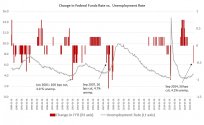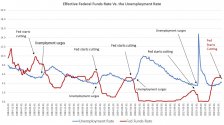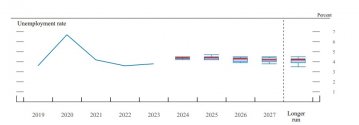Just to be clear:Fed cuts rates by 0.5% to 4.75-5%.
This was the largest cut in the Federal Reserve’s FOMC target rate since March 2020 amid the Covid panic. That pivot finally came today, and more cuts are expected. All of this is a clear signal that the Fed and the FOMC believe the economic situation is worsening. For political reasons, however, Fed Chair Jerome Powell continues and will continue to insist that this month’s big cut in the target rate is definitely, totally, not a reaction to worsening economic data.
However, if we look closely, we will not find a case of the FOMC cutting the target rate by 50 basis points when the economy is “in great shape.” On the contrary, a 50 bps (or more) cut in the target rate tends to occur just a few months before a recession and a rising unemployment rate. If we look only at the unemployment rate in such cases, we can see how the economy can look decent even as the Fed begins a rate-cutting cycle. Over the past thirty years, panic rate cuts of 50 basis points have occurred when the unemployment rate is barely above recent lows:

But unemployment rates inevitably rise after the rate-cutting cycle begins. For example, we see rate-cutting cycles beginning in the late 1980s, in 2001, and in 2007. All precede precessions by a year or less. Furthermore, the Great Recession, which began in December 2007, was preceded by a 50 bps cut just a few months earlier, in September of that year. A year later, the unemployment rate was 6.5%, and it peaked at 9.9% in early 2010.

The FOMC wants everyone to believe that this round of rate cuts will not be like all the others, and yesterday’s 50 basis point cut was merely a calm and controlled effort to steer the U.S. economy into a soft landing. If that were to happen, it would be a first in the Fed’s history.
As I’ve been reporting here, it would be impossible to know what Powell and the FOMC members really think about the economy, of course, because they have to say everything is fine for political reasons. The Fed never comes out and says, “Yeah, folks, we think a recession is going to be here in a few months. Brace yourselves.” It should be remembered that in the spring of 2008, Ben Bernanke was still confidently asserting that there wasn’t even a recession on the horizon—even though the recession had begun in late 2007. This time, true to form, the FOMC members, in their , predicted that the unemployment rate would be flat or falling from now until at least 2027. These predictions run counter to pretty much everything we know about how rising unemployment rates tend to follow—though not be caused by—rate cuts.

The Fed only makes large rate cuts of 50 basis points when it fears substantial job losses. Job losses are a political problem. The reason the Fed doesn’t make such large cuts to its target rate is because cuts to its target rate are inflationary, and price inflation is also a political problem. So where the Fed stands on rate cuts tells us what the Fed believes is more of a political problem at a given point in time: the Fed cuts when it fears more job losses and a recession. A slowing economy will then be disinflationary, and the Fed doesn’t need to worry about price inflation. On the other hand, if the Fed keeps rates steady or allows rates to rise, it will fear price inflation more.
The Fed’s actions are best understood as an acknowledgement of the obvious: the American regime has been misleading the public about the economy as I have been warning. Despite the constant reassurance from the Biden-Harris Administration and its trusted allies in the media that the economy is strong, today’s Fed action was a crisis-level response. The Fed’s specialty is data-driven propaganda, which has a long history of failure.
